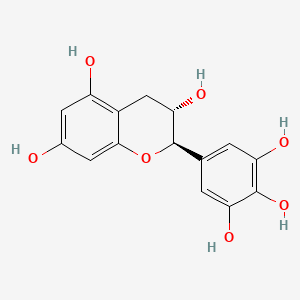| MeSH term | MeSH ID | Detail |
|---|---|---|
| Hemolysis | D006461 | 131 associated lipids |
| Adenocarcinoma | D000230 | 166 associated lipids |
| Lung Neoplasms | D008175 | 171 associated lipids |
| Reperfusion Injury | D015427 | 65 associated lipids |
| Colonic Neoplasms | D003110 | 161 associated lipids |
| Sarcoma 180 | D012510 | 21 associated lipids |
| Body Weight | D001835 | 333 associated lipids |
| Edema | D004487 | 152 associated lipids |
| Precancerous Conditions | D011230 | 48 associated lipids |
| Liver Diseases | D008107 | 31 associated lipids |
Gallocatechin
(+)-gallocatechin is a lipid of Polyketides (PK) class. The involved functions are known as inhibitors and Cell Survival. The associated genes with (+)-Gallocatechin are TERT gene.
Cross Reference
Introduction
To understand associated biological information of Gallocatechin, we collected biological information of abnormalities, associated pathways, cellular/molecular locations, biological functions, related genes/proteins, lipids and common seen animal/experimental models with organized paragraphs from literatures.
What diseases are associated with Gallocatechin?
Gallocatechin is suspected in Hyperinsulinism, nervous system disorder, Obesity, Parkinson Disease, Transient ischemia and other diseases in descending order of the highest number of associated sentences.
Related references are mostly published in these journals:
| Disease | Cross reference | Weighted score | Related literature |
|---|
Possible diseases from mapped MeSH terms on references
We collected disease MeSH terms mapped to the references associated with Gallocatechin
PubChem Associated disorders and diseases
What pathways are associated with Gallocatechin
There are no associated biomedical information in the current reference collection.
PubChem Biomolecular Interactions and Pathways
Link to PubChem Biomolecular Interactions and PathwaysWhat cellular locations are associated with Gallocatechin?
Visualization in cellular structure
Associated locations are in red color. Not associated locations are in black.
Related references are published most in these journals:
| Location | Cross reference | Weighted score | Related literatures |
|---|
What functions are associated with Gallocatechin?
Related references are published most in these journals:
| Function | Cross reference | Weighted score | Related literatures |
|---|
What lipids are associated with Gallocatechin?
Related references are published most in these journals:
| Lipid concept | Cross reference | Weighted score | Related literatures |
|---|
What genes are associated with Gallocatechin?
Related references are published most in these journals:
- Drug Metab. Dispos. (4)
- Cancer Epidemiol. Biomarkers Prev. (2)
- Am. J. Physiol., Cell Physiol. (1)
- Others (7)
| Gene | Cross reference | Weighted score | Related literatures |
|---|
What common seen animal models are associated with Gallocatechin?
Transgenic Model
Transgenic Model are used in the study 'Dietary (-)-epicatechin as a potent inhibitor of βγ-secretase amyloid precursor protein processing.' (Cox CJ et al., 2015).
Rodent Model
Rodent Model are used in the study 'Dietary (-)-epicatechin as a potent inhibitor of βγ-secretase amyloid precursor protein processing.' (Cox CJ et al., 2015).
Related references are published most in these journals:
| Model | Cross reference | Weighted score | Related literatures |
|---|
NCBI Entrez Crosslinks
All references with Gallocatechin
Download all related citations| Authors | Title | Published | Journal | PubMed Link |
|---|---|---|---|---|
| Butler LM et al. | Urinary biomarkers of catechins and risk of hepatocellular carcinoma in the Shanghai Cohort Study. | 2015 | Am. J. Epidemiol. | pmid:25713334 |
| Murphy A et al. | Impact of antioxidants on the ability of phenolic phytochemicals to kill HCT116 colon cancer cells. | 2014 | Free Radic. Res. | pmid:24256565 |
| Suedee A et al. | Anti-HIV-1 integrase activity of Mimusops elengi leaf extracts. | 2014 | Pharm Biol | pmid:24033292 |
| Xiao YH et al. | Transcriptome and biochemical analyses revealed a detailed proanthocyanidin biosynthesis pathway in brown cotton fiber. | 2014 | PLoS ONE | pmid:24466041 |
| Mocanu MM et al. | Epigallocatechin 3-O-gallate induces 67 kDa laminin receptor-mediated cell death accompanied by downregulation of ErbB proteins and altered lipid raft clustering in mammary and epidermoid carcinoma cells. | 2014 | J. Nat. Prod. | pmid:24456004 |
| Magrone T et al. | Human use of Leucoselect® Phytosome® with special reference to inflammatory-allergic pathologies in frail elderly patients. | 2014 | Curr. Pharm. Des. | pmid:23701566 |
| Zhao C et al. | The galloyl catechins contributing to main antioxidant capacity of tea made from Camellia sinensis in China. | 2014 | ScientificWorldJournal | pmid:25243234 |
| Kang SN et al. | In vitro anti-osteoporosis properties of diverse Korean Drynariae rhizoma phenolic extracts. | 2014 | Nutrients | pmid:24763116 |
| Xie H et al. | Catechins and procyanidins of Ginkgo biloba show potent activities towards the inhibition of β-amyloid peptide aggregation and destabilization of preformed fibrils. | 2014 | Molecules | pmid:24759072 |
| Snoussi C et al. | Green tea decoction improves glucose tolerance and reduces weight gain of rats fed normal and high-fat diet. | 2014 | J. Nutr. Biochem. | pmid:24656388 |
